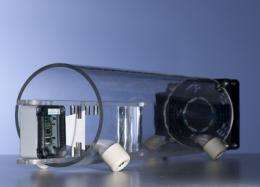Install and Forget: Batteryless Radio Sensors

Siemens has developed a variety of energy autarkic radio sensors that draw the energy they require for operation from their surroundings. The technology can be used to automatically monitor facilities in remote areas, for example. These sensors require no wiring and once installed work completely maintenance-free for many years. They essentially draw their energy from the environment — in the form of light or vibrations — and transmit their measured data by radio.
This makes them suitable for taking measurements at locations where the use of sensors had previously been considered too complex, such as on poorly accessible or moving parts. This enables industrial plants, for example, to be monitored more closely, revealing wear sooner and making it possible to avoid costly plant outages.
Maintenance can then also be performed as needed rather than at fixed intervals. Energy autarkic radio sensors tap different sources of energy depending on where they are deployed. Some are equipped with solar cells; in others, a piezoelectric component absorbs vibrational energy or a thermocouple converts temperature differences into energy. The more efficient these converters work, the more energy is available to the sensor for measurement, evaluation, and data transmission. Radio sensors benefit from the development of energy-efficient electronics because they can perform more complex measurement and analysis functions with the frugal microcontrollers. This is an important aspect in particular for the condition monitoring of bearings or motors, where the sensor has to measure a complete spectrum of structure-borne sound rather than just an individual value to determine whether the device is running smoothly.
The design of a sensor is a function of the prevailing conditions: What energy source is available, what function must be fulfilled and which radio protocols can be used? The researchers at Siemens Corporate Technology draw on their comprehensive experience in the measurement of every parameter imaginable and their expertise in energy-saving radio technology to design complete sensor solutions. They are also working on energy-efficient converters—they are developing solar cells, for instance, in collaboration with the University of Freiburg and the Fraunhofer Institute for Solar Energy Systems.
An important area of application for radio sensors is industrial engineering, and in particular plant construction. However, wireless sensors mounted at the optimal location for the measurement are also advantageous for building systems, in particular for the closed-loop control of the air conditioning system. This technology could also be used in the future by the energy industry to monitor overhead power lines, for instance.
Source: Siemens




















